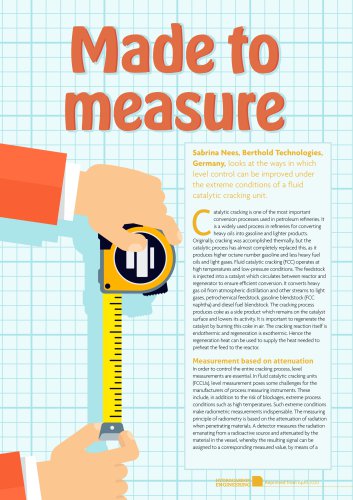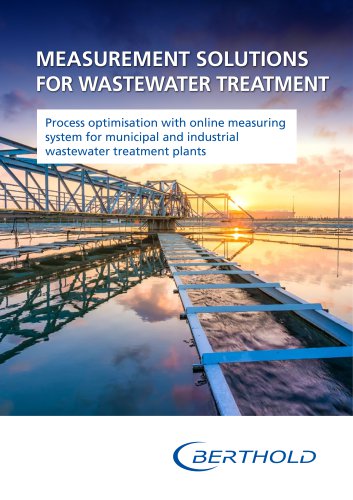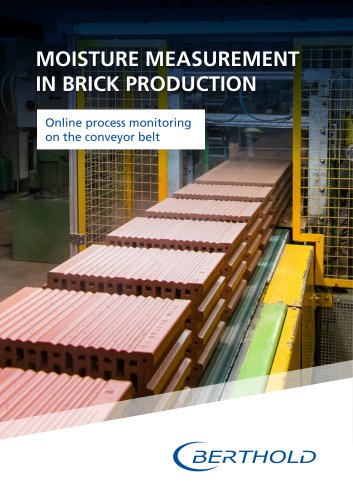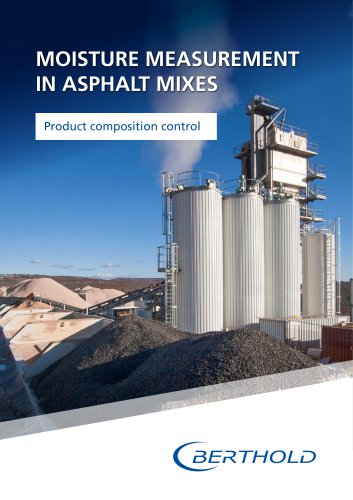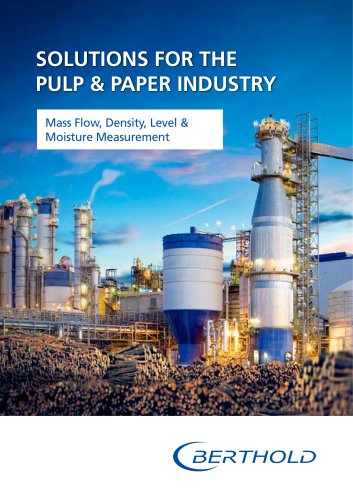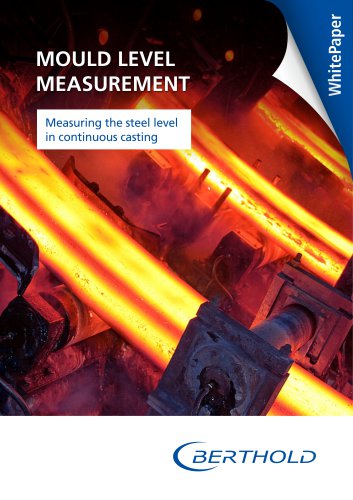
Excertos do catálogo

MEASUREMENT SOLUTIONS FOR THE REFINING INDUSTRY Optimize your production throughput with increased safety and reliability
Abrir o catálogo na página 1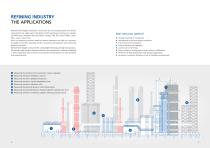
REFINING INDUSTRY THE APPLICATIONS Berthold Technologies radiometric instruments for non-contacting level and density measurement are widely used in the global oil refining industry. Among our customers are well-known companies like Exxon Mobil, Sinopec, Shell, BP, Conoco Phillips, Lukoil, Total – just to name a few. With our measuring solutions based on gamma absorption we help our customers to reliably control their processes and thus ensuring a safe operation and maximizing efficiency and profit. Berthold Technologies is renowned for cutting-edge technology and high-class products. We...
Abrir o catálogo na página 2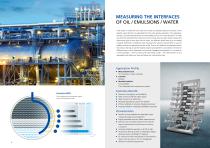
MEASURING THE INTERFACES OF OIL / EMULSIONS / WATER Fresh water is mixed with the crude oil to wash out dissolved salts and minerals. In the desalter vessel the brine is separated from the oil by gravity separation. This separation process is usually characterized by an intermediate zone of oil / water emulsion. To make sure that the retracted brine is free of oil and to ensure that the water doesn’t impact the electrostatic grid or even enter the oil outlet, the different levels have to be controlled carefully. Berthold‘s multiphase level measurement system EmulsionSENS is used to reliably...
Abrir o catálogo na página 3
MEASURING THE LEVEL IN DISTILLATION COLUMNS In the atmospheric distillation process as well as in vacuum distillation, the oil is splitup into different fractions.The oil that is not fractionated ends up in the bottom of the column, where the liquid level is important to measure, to prevent the level from being either too high or too low. If the level is too high, this could lead to tray damage and cause quality issues with products. If the level is too low, this could potential damage pump seals or the pumps themselves. By using the radiometric level systems from Berthold the residue can...
Abrir o catálogo na página 4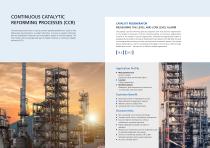
CONTINUOUS CATALYTIC REFORMING PROCESSES (CCR) The chemical process which is used to convert naphthas distilled from crude oil into high-octane liquid products, so-called reformates, is known as catalytic reforming. Here the hydrocarbon molecules are re-arranged by means of chemical catalysts. The most modern and increasingly used type of catalytic reformers is continuous catalytic reforming (CCR). CATALYST REGENERATOR MEASURING THE LEVEL AND LOW LEVEL ALARM The catalyst used for reforming loses its properties over time and thus regeneration of the catalyst is necessary. CCRs are...
Abrir o catálogo na página 5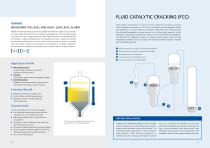
FLUID CATALYTIC CRACKING (FCC) HOPPERS MEASURING THE LEVEL AND HIGH / LOW LEVEL ALARM Reliable and fast responding control of the catalyst level inside the hopper is very important to ensure a high quality process. Each hopper is equipped with continuous level gauges using rod source technology. Rod sources offer highest precision and reliability because the radiation is ideally distributed over the measurement range. Therefore the system will also detect the formation of cones, which means that the true amount of catalyst inside the hopper is determined and filling can be optimized. In...
Abrir o catálogo na página 6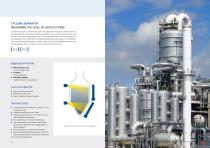
CYCLONE SEPARATOR MEASURING THE LEVEL OF CATALYST FINES Catalyst fines have to be removed from the regenerator flue gas to fulfill regulatory requirements and to protect downstream equipment. Thus cyclonic separators are used to filter out the remaining catalyst fines. The solid particles settle down at the bottom of the separator, where their level is controlled by radiometric level systems from Berthold. The non-contacting technology is ideally suited for this kind of application since dust and temperature have no impact on the measurement performance. Application Profile ■ Measurement...
Abrir o catálogo na página 7
RESID HYDROCRACKING The resid hydrocracking process is becoming more and more important to refiners since it allows a higher conversion rate than other heavy oil conversion processes. It is used to crack heavy fractions to achieve lighter and more valuable products. There are many different processes and technologies established in the market but radiometric measurements from Berthold are applied in all of them. HYDROCRACKER REACTOR MEASURING THE LEVEL & DENSITY ON DIFFERENT ELEVATIONS To achieve optimum control of the cracking taking place inside the hydrocracking reactor, the level of...
Abrir o catálogo na página 8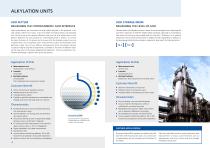
ALKYLATION UNITS ACID SETTLER MEASURING THE HYDROCARBON / ACID INTERFACE ACID STORAGE DRUM MEASURING THE LEVEL OF ACID Light hydrocarbons are converted into high quality alkylate in the presence of an acid catalyst, either HF or H2SO4. In the acid settler the hydrocarbons are separated from the acid due to the density difference and thus the acid settles down at the bottom. Between the two products an intermediate phase is present. To control the layer thickness of this phase and to ensure that the drained products are not contaminated, the multiphase level measurement system EmulsionSENS...
Abrir o catálogo na página 9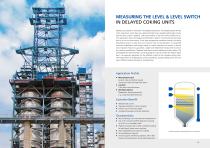
MEASURING THE LEVEL & LEVEL SWITCH IN DELAYED COKING UNITS Residues are cracked or converted in the delayed coking unit. The heated residues are fed to the coke drum where they are cracked into light more valuable hydrocarbon chains and the extra carbon is rejected. Solid coke remains in the drum which slowly fills up. The radiometric level technology from Berthold is ideal for monitoring the coke level due to its non-intrusive nature. Since large temperature variations through the whole operational cycle of a coke drum are a known issue to the operators, our patented automatic...
Abrir o catálogo na página 10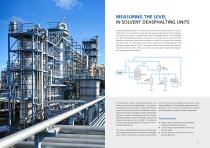
MEASURING THE LEVEL IN SOLVENT DEASPHALTING UNITS Solvent deasphalting (SDA) is a solvent extraction method used to extract up to two thirds of the vacuum reduced crude to be used as good quality feed for a fluid catalytic cracking unit to convert it to gasoline and diesel fuel blending stock. This technology uses light hydrocarbons (propanes to pentanes) as the solvents and uses subcritical extraction methods but supercritical techniques to recover the solvents thus increasing cost efficiencies. This technology can be used in conjunction with delayed cokers and resid hydrocrackers such as...
Abrir o catálogo na página 11Todos os catálogos e folhetos técnicos Berthold Technologies Process Control
-
Density measurement
5 Páginas
-
Continuous level measurement
5 Páginas
-
Retrofit
3 Páginas
-
Article "Made to measure"
3 Páginas
-
Moisture in pasta production
3 Páginas
-
Moisture on cereal, grains & powders
4 Páginas
-
Publication Glass Level measurement
6 Páginas
-
Moisture measurement of gypsum
7 Páginas
-
Glass level measurement
3 Páginas
-
Moisture measurement for wood chips
3 Páginas
-
Solution for pulp and paper production
11 Páginas
-
Density measurement for milk of lime
3 Páginas
-
Brix measurement in the crystallizer
3 Páginas
-
LB 350 Online Moisture Analyser
3 Páginas
-
AOS - Activity Optimized Source
3 Páginas
-
Mould level measurement
4 Páginas
-
FracSENS LB 6770 Density meter
3 Páginas
-
LB 475 Fracturing system
3 Páginas
-
Multiphase level measurement
7 Páginas
-
Nuclear level devices on coke drums
7 Páginas
-
Interface Measurement in desalters
4 Páginas
-
Produkt InlineSENS
4 Páginas
-
Industry Sugar
9 Páginas
-
LB472 Bulk Flow Meter
12 Páginas
-
MEVIS
4 Páginas
-
NUMo - LB 134 UMo II
2 Páginas
-
Radiation Protection Instruments
12 Páginas
-
solutions for Oil and Gas Production
20 Páginas
-
SIL Approved Radiometric Detectors
1 Páginas
-
Certificate SENSseries LB 480
2 Páginas
-
Micro-Polar
16 Páginas
-
DuoSeries Detectors LB 4700
2 Páginas
-
Rod Source Shielding
4 Páginas
-
Safety Source Capsule SSC
2 Páginas
-
Level Switch LB 471
6 Páginas






